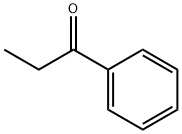Propiophenone
- CAS No.
- 93-55-0
- Chemical Name:
- Propiophenone
- Synonyms
- 1-PHENYL-1-PROPANONE;phenylpropanone;1-phenyl-propan-1-one;Propiophenon;ETHYL PHENYL KETONE;FEMA 3469;usafek-1235;Propiophene;USAF ek-1235;phenylpropone
- CBNumber:
- CB8695754
- Molecular Formula:
- C9H10O
- Molecular Weight:
- 134.18
- MDL Number:
- MFCD00009309
- MOL File:
- 93-55-0.mol
- MSDS File:
- SDS
| Melting point | 17-19 °C(lit.) |
|---|---|
| Boiling point | 218 °C(lit.) |
| Density | 1.009 g/mL at 25 °C(lit.) |
| vapor pressure | 1 mm Hg ( 50 °C) |
| refractive index |
n |
| FEMA | 3469 | PROPIOPHENONE |
| Flash point | 190 °F |
| storage temp. | Store below +30°C. |
| solubility | Difficult to mix. |
| form | Liquid |
| color | Clear colorless to light yellow |
| Odor | at 10.00 % in dipropylene glycol. hawthorn lilac floral aromatic cherry herbal |
| Odor Type | floral |
| Water Solubility | INSOLUBLE |
| Merck | 14,7830 |
| JECFA Number | 824 |
| BRN | 606215 |
| Dielectric constant | 15.5 |
| Stability | Stable. Incompatible with strong oxidizing agents, strong bases. |
| InChIKey | KRIOVPPHQSLHCZ-UHFFFAOYSA-N |
| LogP | 2.71 |
| Substances Added to Food (formerly EAFUS) | PROPIOPHENONE |
| CAS DataBase Reference | 93-55-0(CAS DataBase Reference) |
| EWG's Food Scores | 1 |
| FDA UNII | E599A8OKQH |
| NIST Chemistry Reference | 1-Propanone, 1-phenyl-(93-55-0) |
| EPA Substance Registry System | Propiophenone (93-55-0) |
SAFETY
Risk and Safety Statements
| Symbol(GHS) |  GHS07 |
|||||||||
|---|---|---|---|---|---|---|---|---|---|---|
| Signal word | Danger | |||||||||
| Hazard statements | H227 | |||||||||
| Precautionary statements | P210e-P280a-P370+P378a-P403+P235-P501a | |||||||||
| Hazard Codes | Xi | |||||||||
| Risk Statements | 36/37/38 | |||||||||
| Safety Statements | 26-36 | |||||||||
| WGK Germany | 2 | |||||||||
| RTECS | UG7175000 | |||||||||
| TSCA | Yes | |||||||||
| HS Code | 2914 39 00 | |||||||||
| Toxicity | LD50 orally in Rabbit: 4490 mg/kg LD50 dermal Rabbit 4490 mg/kg | |||||||||
| NFPA 704 |
|
Propiophenone Chemical Properties,Uses,Production
Description
Propiophenone belongs to the family of acetophenones, which is present in some certain cheese, coffee and coffee products, tea and roasted nuts with sweet-smelling odor. It is wisely used as an intermediate in the preparation of other organic compounds, such as synthetic aryl alkenes, like cinnamic acids. It is also a useful intermediate for pharmaceuticals production, such as ephedrine, propiophenone derivatives (cathinone and methcathinone), and especially for the preparation of nervous system drugs (anxiolytic and hypnotic drugs). Besides, due to its naturally pleasant flowery odor, propiophenone can be used as a component in some perfumes.
References
https://en.wikipedia.org/wiki/Propiophenone
https://pubchem.ncbi.nlm.nih.gov/compound/7148#section=Top
http://www.chemicalland21.com/industrialchem/organic/PROPIOPHENONE.htm
https://www.alfa.com/en/catalog/A15140/
Chemical Properties
Propiophenone has a strong, flowery odor. 1-Phenyl-1-propanone is a colorless liquid with a flowery odor, insoluble in water, readily soluble in organic solvents. Typical reactions can be carried out at the methylene group, the carbonyl group, and at the aromatic nucleus.
Occurrence
Reported found in coffee, roasted filberts, roasted peanuts and roasted green tea. Also reported found in Camembert cheese, black tea, roasted macadamia nut, tamarind, dried bonito, cherimoya and sapodilla fruit.
Uses
1-Phenyl-1-propanone is used mainly as an intermediate for pharmaceuticals such as DPropoxyphen, phenylpropanolamine, and Phenmetrazine.
Uses
Propiophenone is an aryl ketone used in the preparation of pharmaceutical and organic compounds. Propiophenone is used in perfumes as well as in the preparation of neurochemical compounds such as ephe drines.
Uses
In perfumery; in the synthesis of ephedrine and related Compounds.
Definition
ChEBI: Propiophenone is an aromatic ketone in which the two substituents on the carbonyl C atom are phenyl and ethyl. It has a role as a fragrance.
Production Methods
Propiophenone is produced by the Friedel–Crafts acylation of benzene with propionic acid chloride in the presence of aluminum chloride. It may also be produced by the reaction of benzoic acid and propionic acid using a calcium acetate– aluminum oxide catalyst.
Synthesis Reference(s)
The Journal of Organic Chemistry, 60, p. 2430, 1995 DOI: 10.1021/jo00113a024
Tetrahedron Letters, 30, p. 4819, 1989 DOI: 10.1016/S0040-4039(01)80517-7
Flammability and Explosibility
Not classified
Safety Profile
Poison by intraperitoneal route. Moderately toxic by subcutaneous route. Mildly toxic by ingestion and skin contact. A skin and eye irritant. A flammable liquid when exposed to heat or flame; can react with oxidizing materials. To fight fire, use foam, CO2, dry chemical. When heated to decomposition it emits acrid smoke and irritating fumes. See also KETONES.
Propiophenone Preparation Products And Raw materials
Raw materials
1of2
Preparation Products
1of4





